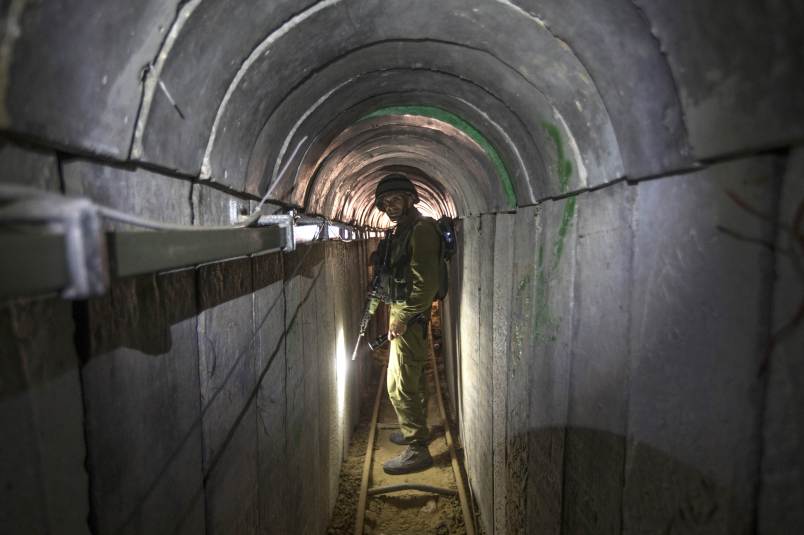JERUSALEM (AP) — Prime Minister Benjamin Netanyahu said Thursday that Israel will destroy the Hamas tunnel network in the Gaza Strip “with or without a cease-fire,” as the military called up another 16,000 reservists to pursue its campaign in the densely-populated territory.
Netanyahu’s vow came as international efforts to end the 23-day-old conflict seemed to sputter despite concern over the mounting death toll, with more than 1,300 Palestinians, mostly civilians, and more than 50 Israelis, almost all of them soldiers, killed since July 8.
“We have neutralized dozens of terror tunnels and we are committed to complete this mission, with or without a cease-fire,” Netanyahu said. “Therefore I will not agree to any offer that does not allow the military to complete this important mission for the security of the people of Israel.”
An initial Israeli aerial campaign against Hamas was widened into a ground offensive on July 17. Since then the campaign has concentrated on destroying more than 30 cross-border tunnels that militants have constructed to carry out attacks on Israeli territory.
Israel says that most of the 32 tunnels it has uncovered have now been demolished and that getting rid of the remainder will take no more than a few days.
The new reserve call-up follows another day of heavy fighting, in which tank shells struck a U.N. school where Palestinians were sheltering and an airstrike tore through a crowded Gaza shopping area. At least 116 Palestinians and three Israeli soldiers were killed Wednesday.
Speaking on condition of anonymity because he was not permitted to discuss the matter with the press, an Israeli defense official said the purpose of the latest call-up was to provide relief for troops currently on the Gaza firing line. However, Israeli officials have also said they do not rule out broadening operations in the coming days.
Fifty-six Israeli soldiers and three civilians on the Israeli side have been killed since the offensive began, as Palestinians have fired hundreds of rockets at Israel — some reaching major cities — and carried out attacks through tunnels beneath the heavily guarded frontier.
Israel has called up a total of 86,000 reserves during the Gaza war, which it launched to try to end rocket fire from Hamas and other armed groups.
Israeli attacks in the strip continued Thursday, with witnesses saying that munitions struck the Omar Ibn al-Khatab mosque next to a U.N. school in the northern town of Beit Lahiya. Israeli fire near another U.N. school in Gaza killed more than a dozen people the day before, drawing international condemnation.
The strike in Beit Lahiya early Thursday damaged water tanks on the roof of a building near the mosque, sending shrapnel flying into the adjacent school compound, where dozens of Palestinians displaced by the fighting had taken shelter.
“The shrapnel from the strike on the mosque hit people who were in the street and at the entrance of the school,” said Sami Salebi, an area resident.
Gaza health official Ashraf al-Kidra said at least 15 people were wounded, with three of them in critical condition.
Kifah Rafati, 40, was being treated for shrapnel injuries at the nearby Kamal Adwan Hospital. She said she and her six children had been sleeping in a classroom facing the mosque when the explosion went off. “There is no safety anywhere,” she said.
On Wednesday Israeli tank shells struck a U.N. school in the Jebaliya refugee camp where some 3,300 Gazans had crammed in to seek refuge from the fighting, killing at least 17 people. The military said it was responding to mortar fire coming from the area of the school.
But Secretary-General Ban Ki-moon called the deadly school shelling “outrageous” and “unjustifiable,” and demanded an immediate humanitarian cease-fire.
“Nothing is more shameful than attacking sleeping children,” the U.N. chief said.
The White House also criticized the shelling of the U.N. school in Jebaliya.
“We are extremely concerned that thousands of internally displaced Palestinians who have been called on by the Israeli military to evacuate their homes are not safe in U.N. designated shelters in Gaza,” said Bernadette Meehan, a spokeswoman for the White House’s National Security Council.
Later on Wednesday, an Israeli airstrike hit a crowded shopping area in the Shijaiyah district in Gaza City, killing at least 16 people, including Palestinian video journalist Rami Rayan, who was wearing a press vest at the time, and wounding more than 200 people, al-Kidra said.
Thursday marked a third day of particularly heavy Israeli air and artillery attacks, at a time when Egyptian cease-fire efforts appeared to have stalled. Israeli media said late Wednesday that Israel’s Security Cabinet decided to press forward with the operation.
Egyptian officials, meanwhile, met with an Israeli envoy about Israel’s conditions for a cease-fire, including disarming Hamas, according to a high-ranking Egyptian security official, who spoke on condition of anonymity because he was not allowed to discuss the delicate diplomatic efforts.
Hamas has said it will only halt fire once it receives guarantees that a Gaza border blockade by Israel and Egypt — tightened after the Islamic militant group seized power in Gaza in 2007 — will be lifted.
Israel says it wants to decimate Hamas’ rocket-launching capability, diminish its weapons arsenal and demolish the tunnels. It has launched more than 4,000 strikes against Hamas-linked targets, including rocket launchers and mosques where it says weapons were being stored.
Israeli strikes have also hit dozens of homes. Mahmoud Abu Rahma of the Palestinian human rights group Al Mezan said nearly half of the Palestinians killed so far died in their homes.
Israeli officials have said Hamas uses Gaza’s civilians as human shields by firing rockets from crowded neighborhoods. Palestinian militants have fired more than 2,600 rockets at Israel over the past three weeks.
However, Pierre Kraehenbuehl, chief of the U.N. aid agency for Palestinian refugees, said Israel must try harder to ensure that civilians are not hurt, especially in Gaza, where 1.7 million people are squeezed into a small coastal territory. His agency has opened 80 of its schools to more than 200,000 Palestinians fleeing the violence.
“What maybe the world forgets … is that the people of Gaza have nowhere to go,” he said. “So when the fighting starts and they move, it is not as if they can cross a border to somewhere.”
___
Barzak reported from Gaza City, Gaza Strip.
Copyright 2014 The Associated Press. All rights reserved. This material may not be published, broadcast, rewritten or redistributed.










SLAUGHTER going on here.
It must be true if it’s in ALL CAPS.
“Terror Tunnels!”, the new “Benghaaaaaaaaziiiiiiiiiii!!!”…
Do you have a preferred term for bombing sleeping kids in a shelter?
It can’t be true if you keep your head in the sand.